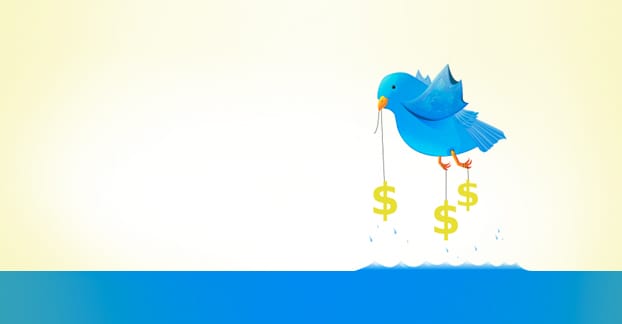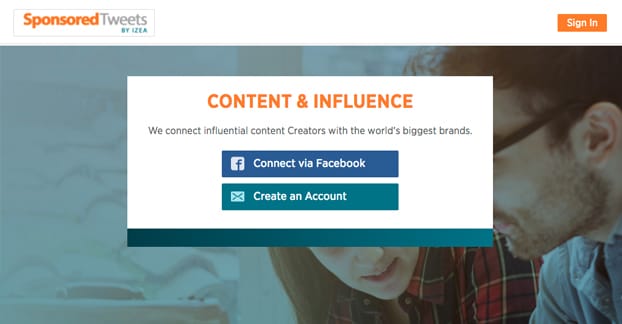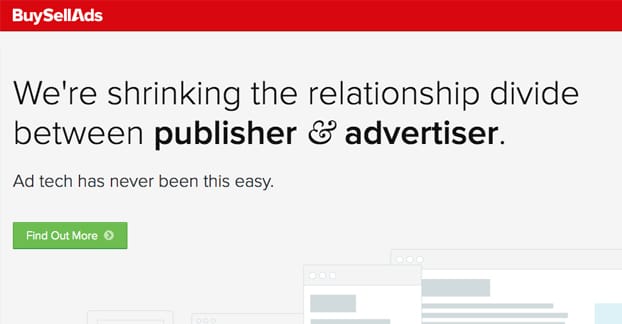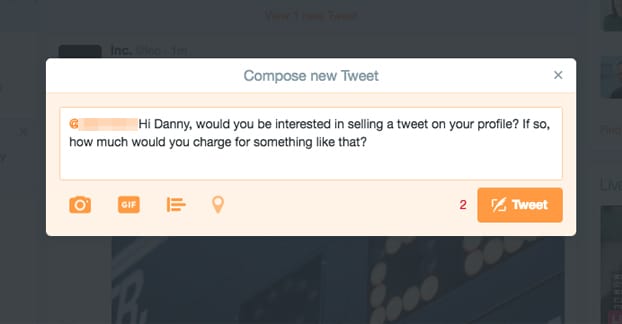Twitter ads are one way to exchange money for more Twitter exposure, but you really have to work to figure out your audience, create ad copy, measure results, and everything else that comes with running ads. It’s so much easier to let someone else do it, and easier still to not even worry about ads.
One such way to live this dream is to make connections and purchase sponsored tweets. How does it work, though, and how can you do it?
The General Idea
The core idea behind a sponsored tweet is pretty simple. You have a message you want to promote. Other people have profiles with tens or hundreds of thousands of followers – or millions if you’re being very ambitious – and a willingness to accept money. You pay them money, they promote your message, and that’s that.
Now, there’s obviously more nuance to it than that. For one thing, Twitter doesn’t like directly paying for tweets. They allow it, and it’s not against their terms of service, but it can come across as spammy. It also cuts out Twitter from the advertising paradigm, and I’m sure they’re a little miffed at the money they don’t make each time one of these transactions happens.
Twitter won’t ban anyone for buying a sponsored tweet. What they will ban is anyone selling automatic sponsored tweets on their feeds. The automation is the key, here, and this falls under automated posting, which Twitter has strict rules about. Since you’re looking to buy, not to sell, you don’t have to worry about being banned.
I would caution you to avoid paying for bot services regardless. If they’re automating their posting, they’re probably automating other things as well. Chances are, a large number of their followers are bots as well, and then you’re just paying for no one to see your sponsored tweet.
There are a handful of different ways you can approach sponsored tweets.
Method 1: SponsoredTweets
This method relies on the website SponsoredTweets.com, which provides the means to connect people buying and people selling sponsored tweets. They work with Facebook as well, and you can sign up via email if you wish.
How does it work? You sign up as an advertiser, since this is what you’re doing. You’re essentially just paying for Twitter ads through an advertising system other than Twitter’s. You have some options to set, though you can be as specific or as broad as you want.
- Provide the specific tweet, link, keyword, or other directions for the tweet content itself.
- Set the amount you’re willing to pay, either per tweet or per link click, depending on how you set up the system.
- Set any targeting options you want to specify, like the location of the promoter.
All of this is a way of filtering the list of people who are selling tweet spots on their feeds. When you click to continue, you’ll be given a list, with some key information about them. You’ll see their individual tweet price, their follower counts, their click rates, and so on. You can use this data to judge them and choose which of them you want to tweet your message. When you select them and confirm that selection, the Twitter user in question will be sent the tweet instructions and will be able to decide if that’s something they’re willing to promote or not.
This is why your targeting options are important. You’re searching for people who will be relevant to your brand and who will be more likely to accept your tweet pitch. If you just shoot it at the wall, you’ll get a lot of people with small audiences accepting it and taking money for basically nothing, and you’ll get a lot of people with irrelevant audiences rejecting it because it doesn’t fit their persona.
There are some pros and cons to this option. The pro is, of course, that it’s an established system with people you know are willing to publish your tweet, for the right price and with the right subject. On the other hand, you do need to take the time to specify targeting options to find the right users. Also, in fringe niches, you might not find users with any reasonable profiles you want to spend the money on.
Want to see how your tweet might look? Check out this link. It’s the Twitter search results page for the specific link shortener that SponsoredTweets used back in 2013 and 2014. They’ve changed their system since then, but it will largely look the same; people tweeting more or less normal content, all with the caveat that they have #ad added to their messages.
That’s the other thing, and it applies to all forms of sponsored tweets; Twitter requires disclosure, so they will have to have #ad or some other form of sponsorship notification. They don’t have to disclose what you paid, or even who you are if you’re advertising for someone else, they just have to disclose that the tweet was paid for.
Method 2: BuySellAds
BuySellAds is an independent ad network that doesn’t really serve ads, so much as it serves as a marketplace where advertisers and publishers can hook up and make deals. It works in very much the same way as the first method, except you don’t have to put in targeting options to see users. You simply find the “tweets” tab at the top of the interface and click it. You’ll be shown a list of Twitter publishers and their name, bio, and pricing. You can filter it using categories and various specific options. When you find a Twitter user who fits your profile and your budget, you can click to purchase from them and upload your ad creatives to them. This also includes scheduling options, making it more advanced than SponsoredTweets.
There are two primary pros to using BuySellAds. The first is that they work with more than just tweets. You can use them for generalized ads with publishers all throughout the web, without needing multiple accounts or managing multiple systems. The second pro is that the Twitter user search is much more robust and easier to use than method 1.
On the other hand, you do have to individually purchase, schedule, and upload your sponsored tweets to each Twitter user individually. If you have individual messages for each user, that’s fine, and honestly you should be customizing your messages to look less like ads. However, if you were just looking for bulk uploads, you won’t find them here.
And, of course, you’re going to have the #ad disclosure on all of the tweets you purchase. You won’t be able to get around this at all if you’re using a third party system.
Method 3: PaidPerTweet
PaidPerTweet is very much like the previous two systems. It works the same sort of way; publishers join, set their prices, and verify themselves as users. Advertisers buy tweet space in the feeds of those users. You can even see a selection of their enrolled users and the prices. For example, for $2,000 you can get George Lopez to tweet your message to his three million followers. Or his two million followers, as his actual profile indicates. That’s one thing you’ll notice; the follower numbers are a little inflated. Most profiles I check ended up having 20-40 percent fewer followers than indicated. However, they did still all have quite large followings, so it doesn’t really matter.
Prices range from $5 to $3,000, which is the highest I’ve seen. There are plenty of fakes added to their database with insane prices, like someone charging a million bucks for a tweet on their profile with 0 followers, but those are obviously not intended to scam people. The $3,000 profile, by the way, was this guy.
That link brings up something you’ll want to pay attention to, which is activity. Jose there hasn’t tweeted since 2014. I wouldn’t recommend paying $3,000 to get him to post for you.
Method 4: Manual Searching
At the end of the day, maybe you just haven’t found anyone in your niche on these sites, or maybe you have, but their prices are outrageous so it’s clearly meant for high rollers only. The one remaining option you have is to try to set up a deal manually.
There are of course pros and cons to the manual option. On the plus side, you can reach and make deals with people who otherwise would not even think to sell places on their feeds. This means less competition and more genuine engagement, since your sponsored tweet looks more like an organic recommendation. Additionally, you can negotiate your own price, which can be cheaper than what you see on most of these ad networks. You can also reach people you know for a fact are relevant to your audience, rather than people who may or may not be.
You also have the potential fringe benefit of keeping things secret. It’s not good business practice – and it might get you in trouble with some authorities if they find out – but you can potentially get Twitter publishers to share your message without the disclosure.
On the other hand, you have to do all of the legwork yourself, including all of the tracking, negotiations, and payments. You have to:
- Identify accounts you would want to have publish your tweet.
- Approach those accounts and ask them if they’re willing to publish a sponsored tweet.
- Negotiate a price point with the people who are willing to publish a sponsored tweet.
- Create the ad copy, with or without disclosure as necessary, using links with tracking features either through a shortener service like bit.ly or through UTM parameters.
- Make sure the user actually publishes your sponsored tweet to their audience and pay them for it on your agreed upon schedule.
This is quite the process, and it has a bunch of different points of failure. Let’s take it one step at a time.
First, you need to identify the accounts you would like to be shared by. This will be similar if not identical to your list of influencers. You can read about identifying influencers here. In general, you’re looking for people with moderate to large followings. Those people need to be at least somewhat associated with your industry. It’s no use getting Katy Perry to tweet about your business selling vacuum cleaners. Okay, well, there is, since product celebrity endorsements are a time-honored tradition, but still. The price of getting Katy Perry to shill your item versus someone with a smaller, more targeted following is going to lean the scales in the favor of the smaller publisher.
Next, you need to approach them. I recommend composing a lovely DM talking about how you’re a fan, how you’re a content producer in the same industry looking to get a leg up, and that you’re wondering if they’re interested in publishing a sponsored tweet for you.
Some people will ignore you. Some will say no. Some will refer you to a profile on BuySellAds or one of the other systems for you to use. Some of them will respond with prices. Some will express interest but be unsure of the whole process. Make your next decision accordingly. If the price is too high, don’t go for it. If the user says no, don’t press them.
What sort of prices are you looking for? This is a question you’ll have to answer based on your advertising budget. I mentioned above that some of these sites see anywhere from $5 to $3,000 for a tweet. It really depends on the number of followers the account has, how relevant to your industry they are, and how well you negotiate.
After that, it’s all monitoring. Make sure you pay up, make sure you get what you paid for, and make sure you’re keeping track of how well it worked so you know whether or not it’s worth trying again.








